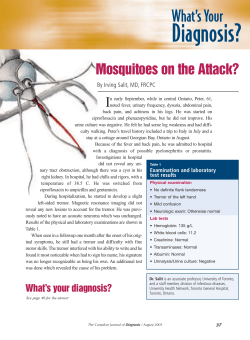
Immunology and Infectious Disease Meeting: Encephalitis Dr David Tran Immunology Registrar
Immunology and Infectious Disease Meeting: Encephalitis Dr David Tran Immunology Registrar John Hunter Hospital 10th of November 2014 Outline Encephalitis What are we missing? Arbovirus Encephalitis Murray Valley Encephalitis Virus West Nile Virus Encephalitis Lethargica Autoimmune Encephalitis Encephalitis Encephalitis is inflammation of the brain parenchyma. It is a rare complication following infection and autoimmune illness Symptoms include fever, reduced neurological function, altered consciousness, seizures, radiological and histopathological changes. Encephalitis can result in fatality and long term disability and sequelae. Microglial Nodule Perivascular cuff Murray Valley Encephalitis MVE Epidemics Murray Valley Encephalitis (MVE) has the potential to cause outbreaks of neurological symptoms in human Isolated by E French, MJA, 1952 Causative agent of 1951 and 1974 epidemic of encephalitis in the Murray Valley district. Clinical and pathological of links with Australia X-Disease (1917,1918,1925)1 MVE found in sporadic cases in endemic locations: central, northern Australia, and PNG2 1. Anderson, S (1954) “Murray Valley encephalitis and Australian X disease”, J Hyg 52(4) p445-460 2. Anderson, S. G., Price Av, N.-K., & Slater, K. (1960). "Murray Valley encephalitis in Papua and New Guinea. II. Serological survey, 1956-1957". Med J Aust 47(2), 410-3. Murray Valley Encephalitis +ve sense ss RNA (11kb) flavivirus, flaviviridae family Japanese encephalitis West Nile Virus Yellow Fever Hepatitis C Virus (family) Diagram: R.McKendall, W Stroop,”Handbook of Neurovirology” 1994 Marcel Dekker Inc NY p382 Transmission Vectors Dead End Host6 Humans Horses Dogs Fowl (chickens) Culex annulirostris (ARTHROPOD VECTOR )3 Water Birds4 (VERTEBRATE HOSTS) (National MVE Surveillance Program)5 3. McLean, D. M. (1957). "Vectors of Murray Valley encephalitis". J Infect Dis 100(3), 223-7. 4. Anderson, S. G. (1953). "Murray Valley encephalitis: a survey of avian sera, 1951-1952". Med J Aust 1(17), 573-6. 5. Broom, A. K., et al, (2001). "Australian encephalitis: Sentinel Chicken Surveillance Programme". Commun Dis Intell 25(3), 157-60. 6. Anderson, S. G., Donnelley, M., Stevenson, W. J., Caldwell, N. J., and Eagle, M. (1952). "Murray-Valley encephalitis; surveys of human and animal sera". Med J Aust 1(4), 110-4. Murray Valley Encephalitis Virus 1951 and 1974 MVE Outbreak in the Murray Valley district. Australia XDisease (1917,1918,1925) Endemic locations: central, northern Australia, and PNG Public Health warnings in during the wet season. Distribution of Cases Serology survey (98/114)7 Aboriginal population in the NT (1956) Broken Hill (NSW) (1953)8 those born before 1919 increase proportion of neutralizing antibody High serological response in Murray Valley community during 1974 outbreak9 7 Miles, J. A., and Dane, D. M. (1956). "Further observations relating to Murray Valley encephalitis in the northern territory of Australia". Med J Aust 43(10), 389-93. 8 Anderson, S (1954) “Murray Valley encephalitis and Australian X disease”, J Hyg 52(4) p445-460 9 Doherty, R. L., Carley, J. G., Filippich, C., White, J., and Gust, I. D. (1976). "Murray Valley encephalitis in Australia, 1974: antibody response in cases and community". Aust N Z J Med 6(5), 446-53. Clinical Manifestations N. Bennet “Murray Valley Encephalitis 1974: Clinical Features” MJA 1976(2)12,p445 22 cases of MVE admitted to Fairfield Hospital, Melb Incubation period 10-20 days Age range (3-74); young > old; male > females Prodromal symptoms Fever lasting 4-13 days, daily peak 40.5 oC Associated headache, nausea & vomiting, photophobia Early altered consciousness: drowsiness (12); confusion, disorientation, behaviour changes (7) Ataxia(6); aphasia(6), grand mal (tonic-clonic) seizure(8) Clinical Manifestations Severity Fatal 4 of 22 pt died (18%) Severe (7) Residual physical / mental disabilities (5) respiratory failure (improved with artificial respiration) Mild (11) LOC, spastic followed by flaccid quadriplegia, respiratory failure. Complete recovery (7); mild degree of imparied motor skills, mental acuity, Asymptomatic sero-conversion Clinical : Sub-clinical infection ratio 1:1000 Neuroradiology: MVE Diffusion-weighted image of the Brain Cervical spine show diffuse hyperintensity of the spinal cord Einsiedel L 2003 Survillance and Management Supportive management Access to Invasive Ventiliation Survillance program: Sential groups Public Health Notification Vector Control ?Research into vaccinations Other Emerging Infections Japanese Encephalitis West Nile Virus Affects 20,000-50,000 people pa, Asia 3 cases in Torres Strait Islands 1995 Never been reported in western hemisphere till Sept 1999: 63 cases Continued seasonal cases, and spread of WNV Niphan Virus; Hendra virus; West Nile Virus First reported in western hemisphere (Sept 1999) 63 cases NY city Japanese Encephalitis - Affects approx 50,000 people per year - 3 cases in Torres Strait Islands (1995) West Nile Virus Geographic Distribution of WNV in USA 2003 2003 Human Cases 2866 Neurological illness Total of 9862 human infections 264 confirm deaths due to WNV Geographic Distribution of WNV in USA 2007 WNV Infection 3630; Neurological Illness 1217; Fatal Case 124 Viremic Blood Donor Activity in the United States 2007 WNV Human Neuroinvasive Disease 2007 (encephalitis and/or meningitis) WNV West Nile Virus: Clinical presentation Most individuals infected with West Nile virus are asymptomatic. The incubation period is 2–14 days before symptom onset. Prodromal flu-like symptoms <1% of infected individuals develop severe neuroinvasive diseases West Nile meningitis West Nile encephalitis acute flaccid paralysis West Nile meningitis and encephalitis Fever and signs of meningeal irritation headache, stiff neck, nuchal rigidity, and photophobia Altered level of consciousness, disorientation, and focal neurology dysarthria, seizures, tremor, ataxia, involuntary movements, and parkinsonism Acute flaccid paralysis Main clinical feature was acute asymmetric flaccid paralysis Minimal or no sensory disturbance Most patients had substantial muscle ache in the lower back; Disturbed bowel and bladder functions in some patients. Outcomes Highly variable recoveries rate Complete recovery in weeks Ongoing Wheelchair requirements Asymmetric flaccid paralysis Lancet Neurology 2007: 6 p171-181 Diagnosis of WNV Serum WNV IgM or 4 fold rise in titre RT-PCR Pleocytosis on LP MRI changes Pons Substantial nigra Thalamus Anterior Horns – spinal cord Neuroradiology Findings MRI Brain FLAIR: shows abnormal signals in bilateral thalamus and other areas of basal ganglion. MRI Spine with Contrast: spinal roots are significantly enhanced Lancet Neurology 2007: 6 p171-181 Outcomes in WNV Encephalitis / Meningitis Colorado Series 221 hospitalized patients with WNV Encephalitis 18% died (risk factors intubation, previous stroke, immunosupression) 25% return home 46% requiring rehab or long term placement Meningitis No deaths 90% return home 9% rehab / placement Annual of Neurology 2006 60(3),p288 Summary Neuroinvasive Flavivirus are an emerging infection WNV Spread in North America West Nile meningitis West Nile encephalitis Acute flaccid paralysis Similar Clinical presentation, pathology and radiological findings in MVE Future risk of MVE outbreak or introduction of other arbovirus such as Japanese Encephalitis into the Australia eco-system. Encephalitis Lethargica Between 1917 to 1928, an epidemic of encephalitis lethargica spread throughout the world - “sleepy sickness”. Associated with 1918 Influenza pandemic Post-encephalitic Parkinson's disease may develop after a bout of encephalitis First described by neurologist von Economo Ms NM 21 year old international student from Indonesia. High achiever on the Dean’s Honour Role for biomedical science. No significant past medical history / family history Non-smoker, No Alcohol or illicit drug use No regular medications Presentation Presented to the emergency department with sister and close family friend 5 day history of declining mental state, increased anxiety and agitation, poor sleep and reduced oral intake. Confused, with bizarre behaviour and thoughts. Initial CT Brain and Blood Test: Normal Admitted to the psychiatric unit: Acute psychosis Psychosis Day 1 of admission: Increased confusion and agitation. Only muttering single words. Developed shuffling gait, and incontinence. ? Catatonic Psychosis - Electroconvulsive therapy ECT Decline in conscious state - febrile and neck stiffness. Transferred to the General Medical / Neurology unit Seizures Increasingly nonresponsive (GCS 10) Non-Convulsive status epilepticus on EEG. Ovarian Cyst noted on US - benign PET Scan: normal: no definite malignancy noted MRI / LP - no cause found for reported symptoms Empirical Management Intravenous methylprednisolone - 3 days Intravenous Immunoglobulin - over 5 days Two week of Acyclovir Cyclophosphamide considered but deferred due to patient’s age Rituximab Infusion (Anti-CD20 therapy) Progress Gradual Improvement in mental state and functional capacity over many months in rehabilitations Limbic Encephalitis Clinical Syndrome Subacute memory impairment Disorientation and agitation Seizure, hallucinations, sleep disturbance Classification Infectious Autoimmune Paraneoplastic / non-paraneoplastic mechanisms Autoimmune Channelopathies Neuronal antibodies against cellsurface antigens Autoimmune Channelopathies Essential roles in the process of neurotransmission Voltage-gated potassium channels (VGKC) regulate the release of neurotransmitters N-methyl-D-aspartate receptors (NMDA-Rs) postsynaptic receptors Ovarian Teratoma & NMDA Twelve women (14–44 years) developed prominent psychiatric symptoms, amnesia, seizures, frequent dyskinesias, autonomic dysfunction, and decreased level of consciousness Eleven patients had teratoma of the ovary (six mature) and one a mature teratoma in the mediastinum N-methyl-d-aspartate (NMDA) receptor All had serum/cerebrospinal fluid antibodies that predominantly immunolabeled the neuropil of hippocampus/forebrain, in particular the cell surface of hippocampal neurons, and reacted with NR2B (and to a lesser extent NR2A) subunits of the NMDAR. Mr VG 61 year old man presents with sudden onset of memory impairment and confusion Previously high functioning, works as a lecturer in university Background Type I DM Hypertension Hyperlipidaemia Presentation Co-lateral history from family Patient awoke in the morning and noted to be vague In the afternoon, found at the kitchen table, still in his pyjamas. Confused, with poor recall of recent events Normal neurological exam Mini-Mental State: Impaired object recall, short term memory No evidence of hypoglycaemic episode (BSL 10.5) Investigations Classical Neuronal Antibodies (Hu, Ri, Yo): Negative Lineblot with Ma/Ta, CV2, Amphiphysin: Negative NMDA-Receptor: Negative CT Neck Chest / Abd / Pelvis: mesenteric lymph node Normal Testicular ultrasound Management IV Acyclovir 3 days of methylprednisolone 5 days of IVIG Gradual Improvement in memory Patient was transferred to rehab Voltage-gate potassium channel result available 498 pM (<85) VGKC autoantibodies Peripheral nervous system disease Neuromyotonia Cramp-fasciculation syndrome Central nervous system Morvan syndrome: neuromyotonia, autonomic, sleep, cognitive dysfunction Epilepsy Limbic encephalitis Radioimmunoassay Nuclear isotope assay Requires the use of gamma counters Process Radiolabelled (usually I125) antigen (VGPC) mixed and incubated with patient serum VGPC antigen-antibody complex (precipitated using buffering solution) - leaving unbound VGPC antigen in solution Precipitated complex is centrifuged and supernatant aspirated Residual radioactivity in pellet proportional to level of VGPC Ab in patient serum 24 sera from unselected patients controls 10 patients with symptoms of limbic encephalitis. “On the limited evidence available, we suggest that this condition is treated initially with IvIg or plasma exchange to try to obtain a quick clinical response, followed by high-dose prednisolone for at least 6 months. If the antibody remains high, alternative immunosuppression may be useful.” What is the ideal approach??? Approach to Investigation Clinical Syndrome CSF: inflammatory changes MRI ⁄ PET: temporal lobe abnormalities EEG: temporal lobe abnormalities exclude other causes BIOCHIP Mosaics™ (Brisbane) Autoimmune Encephalitis Mosaic 1 (Euroimmun) Glutamate receptor (type NMDA) Glutamate receptor (type AMPA1 Glutamate receptor (type AMPA2) Contactin-associated protein 2 (CASPR2) Leucine-rich glioma-inactivated protein 1 (LGI1 GABA B receptor COST?? – Approximately $80-100 a well Acknowledgements Immunology Unit A/Prof Michael Boyle Dr Theo de Malmanche Dr Glenn Reeves Dr Kathryn Patchett Hunter Area Pathology Service Immunology Laboratory Karla Lemmert
© Copyright 2025












